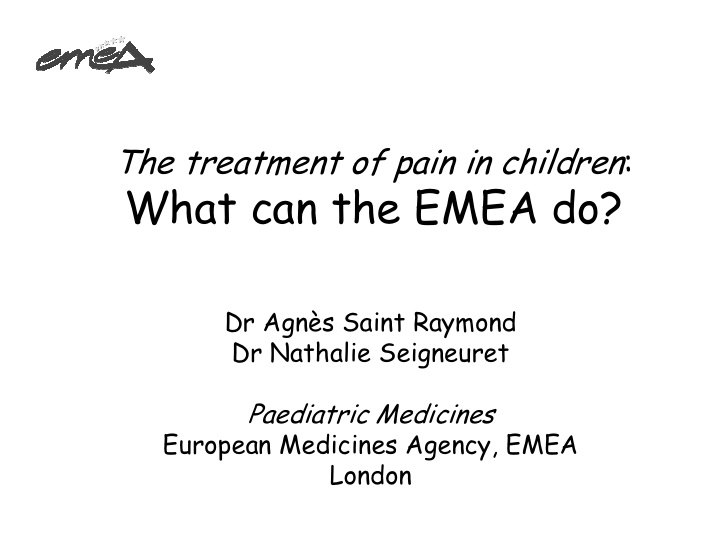



The treatment of pain in children : What can the EMEA do? Dr Agnès Saint Raymond Dr Nathalie Seigneuret Paediatric Medicines European Medicines Agency, EMEA London
EMEA: a networking Agency • EMEA is not FDA for Europe • EMEA co-ordinates existing scientific resources of Member States • Activities: Scientific Advice, Orphan drug designation, Marketing Authorisation (centralised), Pharmacovigilance, Databases (EUDRACT), etc.
The European Regulatory Framework GRANTING MARKETING AUTHORISATION CENTRALISED PROCEDURE Rapid and EU-wide authorisation for innovative medicines EMEA European 1 evaluation (<210 days), Commission 1 authorisation, 19 languages!
Why do we need a Regulation? The current situation: • ~22% of the EU population, 100 million, aged less than 18 • 50-90% of paediatric medicines have not been tested and evaluated • No request from industry, no reliable information available to prescribers • Risks of adverse effects (over-dosing) or inefficacy (under-dosing) • Proper formulation often not available • Children may be denied innovation
Why do we need a Regulation? Medicines for children: experience with centralised procedure Total number of approved substances: 175 (January 2003) Corresponding to 234 MA 25% 31% Paediatric indication 44% Potential paediatric use Not applicable
European Initiative • Started in 1997 • 2000: Council Resolution (December) • 2001-2002: ‘Better Medicines for Children’ - Public Consultation • 2003-2004 – Extended Impact Assessment – Consultation and Draft proposal
The legislative process 2004 –Draft Regulation after Public consultation (4/2004) – Adoption of Commission proposal – Official Draft Regulation (9/2004)
What’s next? Co-Decision process Lobbying! European Commission MS Council of Ministers European Parliament • - 1 st readings 2005 - 2 nd readings 2006 • Entry into force 2007
Objectives of the Regulation • Improve the health of children – Increase high quality, ethical research into medicines for children – Increase availability of authorised medicinal products for children – Improve information available • Achieve the above – Without unnecessary studies in children – Without delaying authorisation for adults
New products • Patent-protected products – Obligation to submit Paediatric Investigation Plan (PIP) before marketing authorisation, or variation – Reward : 6-month extension of the patent protection (= Supplementary Protection Certificate)
‘Old’ products • Off-patent products – Paediatric Use Marketing Authorisation (PUMA) • Incl. Formulation • Optional – Incentive : Data protection/exclusivity: 10 years ( as for new products )
Paediatric Committee
Paediatric Investigation Plans • Ensure availability of data in the paediatric population • Waivers • Deferrals • Agreed plan and results serve as basis for evaluation of the marketing authorisation application
In the meantime . . . Creation of the Paediatric Expert Group (PEG) by the Committee for Human Medicines (CHMP)
PEG • Assessment of paediatric NEEDS (e.g. pain) • List of PRIORITIES for research on old products • Recommendations and contributions to guidelines (e.g. neonates, pharmacovigilance, Pharmacokinetics, formulations of choice) • Liaison with Learned Societies (e.g. ESPGHAN)
PEG and pain • Methodology • Use of needs list established by the French ‘Comité d’Orientation Pédiatrique’, in liaison with learned societies and experts • Consultation of all Member States to get a ‘European’ list • Consultation of European and national Learned Societies • Finalisation of list by PEG • NEXT STEPS?
PEG and pain NEEDS • Agreed List – Products of interest, old and new/future – Excluding migraine (another list) – Assessment to be done? – Clinical trials to be performed/availability of data? – Paediatric formulations? • Consultation of Industry – Trade association (EFPIA’s paediatric group) – Individual companies
PEG and pain NEEDS • Limitations of the method – No real legal framework – Need for thorough assessment of available data* – Formulations –if any- not available in all Member States – What if little interest from companies? – Preparatory work for Paediatric Committee
PEG and pain NEEDS • Products identified by PEG: – Acute pain / Chronic pain – Mild / Moderate/ Severe
PEG and acute pain • Moderate: • Severe: – Tramadol – Morphine – Diclofenac – Metamizol? – Fentanyl – Clonidine – S-Ketamine – (Cox-2 inhibitors?) – local anaesthetics – Sucrose (neonate only) (bupivacaine) – topical anaesthetics • Mild: – Paracetamol – Ibuprofen
PEG and chronic pain Moderate: • Severe: – Piroxicam (melt) – Morphine – Ketoprofen? – Opioids/antiepileptics – Naproxen – Opioids/antidepres- – Tramadol sants? – Metamizol? – Fentanyl – Clonidine – S-Ketamine – Local anaesthetics (Lidocaine • Mild transdermal?) – Paracetamol – Ibuprofen
Next steps • Publication of the list • Liaison with Industry • Awareness of Learned Societies on the need to perform trials • Feed back from Workshop
Conclusions • Pain is common to all children • Marketing authorisations are not simply administrative burden! • New Regulation intended to improve the future • Harmonisation of practices and discussion of needs. • Work of PEG to be shared/discussed • Preparation of the Work of the Paediatric Committee
Websites • EMEA www.emea.eu.int (+ links to EU national agencies) • European Union www.europa.eu.int • DG Enterprise pharmacos.eudra.org • DG Research www.cordis.lu
Recommend
More recommend